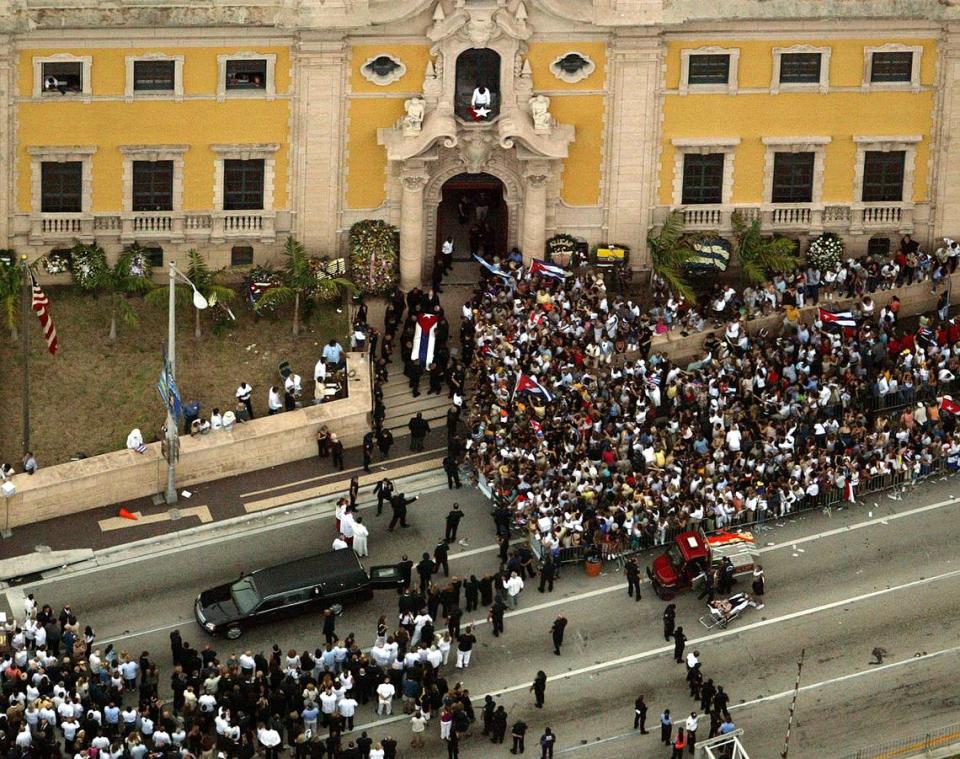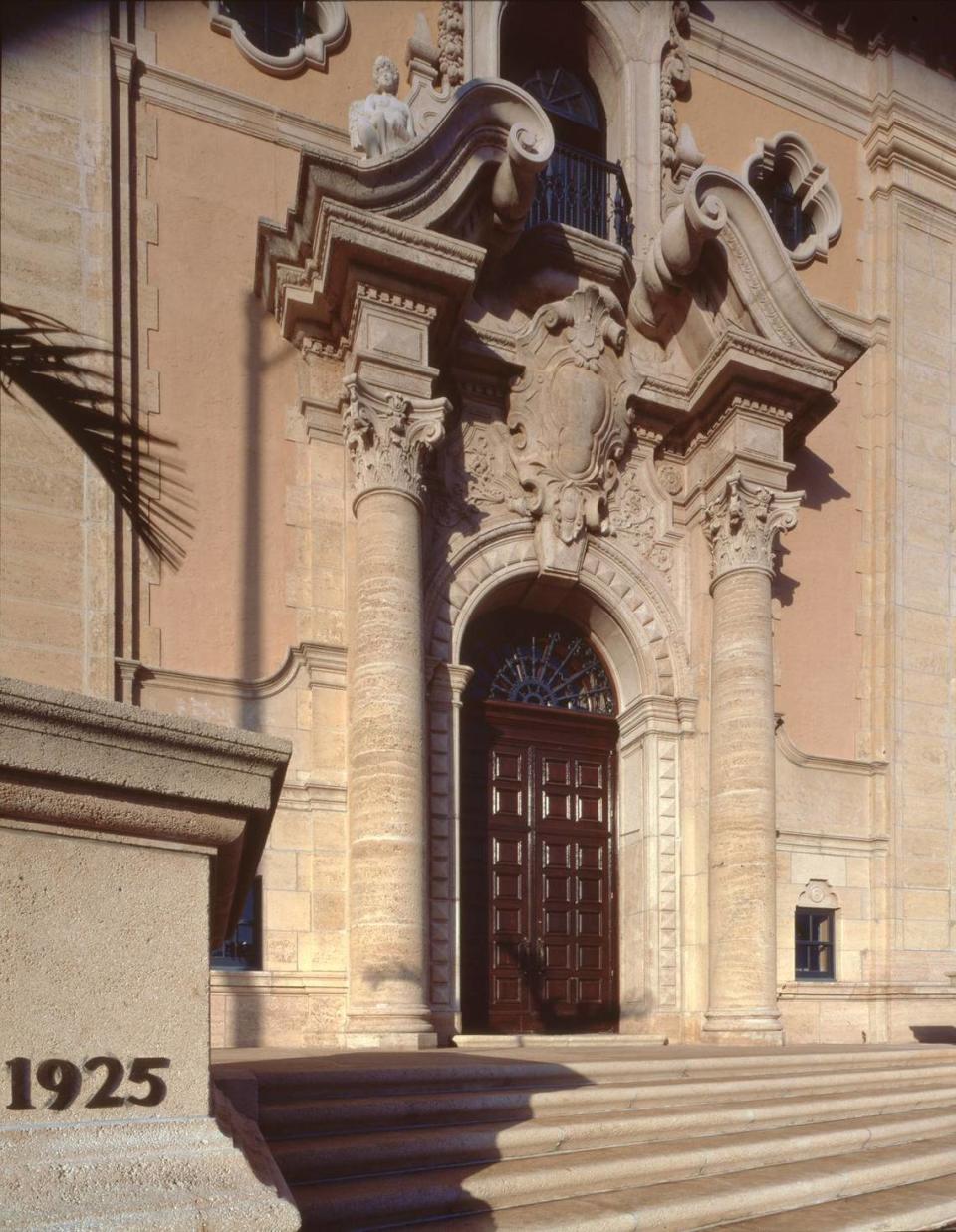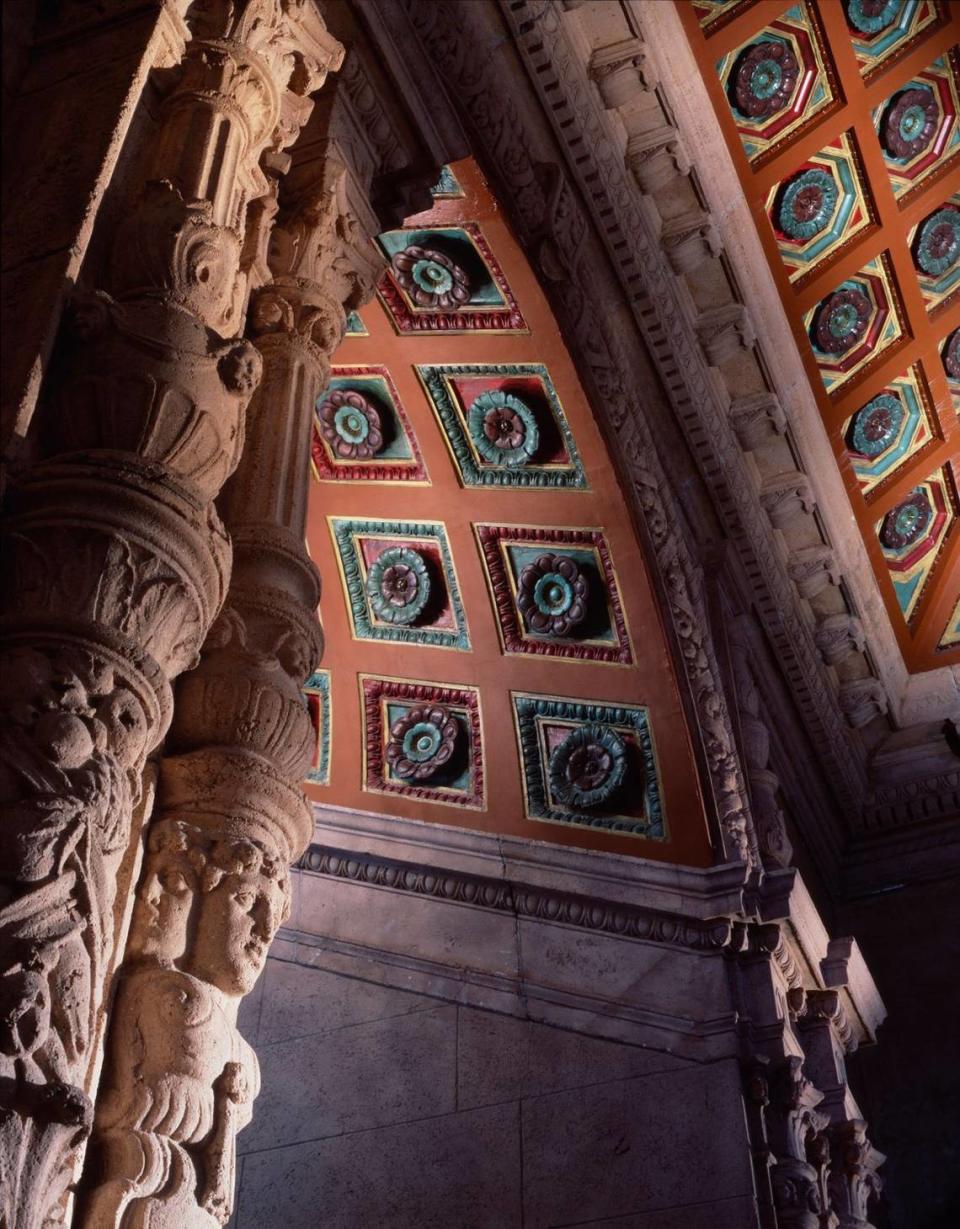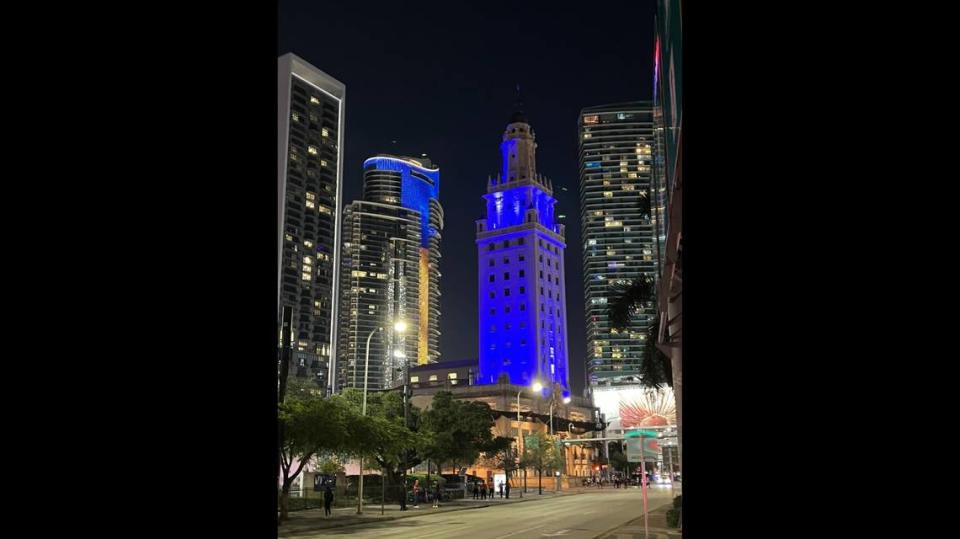Miami’s cherished, historic Freedom Tower shut down for a $25 million restoration
For 98 years, the Freedom Tower has stood as a symbol of Miami, a cherished, unifying landmark in a city of constant change.
Now it’s shutting down. But fear not, the closure is only temporary, and all for the better.
Miami Dade College is embarking on a badly needed $25 million renovation of the tower, a national historic landmark and one of the few buildings in the city that fully deserves the overused label of “iconic.”
The two-year rehabilitation project, which entails extensive structural and other interior repairs as well as a top-to-bottom exterior restoration, won’t change the tower’s heavily ornamented Mediterranean appearance, inside or out, nor its role as the home of the college’s Museum of Art and Design and administration for the school’s renowned cultural programs.
But the building will emerge rejuvenated, strengthened and ready for its second century as a centerpiece of downtown Miami, college administrators and project architects say.
“The Freedom Tower means so much to this community for so many of the obvious reasons,” Miami Dade College President Madeline Pumariega said in an interview. “But now we have so many people coming to Miami who don’t know the history, and who are fascinated by it when they do hear it. And so I think this project ensures the Freedom Tower will continue to be the iconic treasure of Miami that it is today.”
The tower — more than once imperiled during a topsy-turvy history that closely mirrors the city’s — is scheduled to reopen in 2025 with a splashy centennial celebration befitting its subject.
School officials say a series of events will highlight the Freedom Tower’s place in early Miami history, when it was built as the grand headquarters of the rapidly growing city’s oldest and biggest newspaper, the Miami News, as well as its later role as a symbol of hope and liberty for Miamians, in particular the thousands of Cuban exiles who passed through its massive oak doors in the 1960s when it served as a federal refugee center.
The tower has been the site of numerous political demonstrations and has hosted high-profile ceremonies for prominent guests over the years, including American First Ladies and foreign royalty — not just the King and Queen of Spain, in 2015, but Cuban royalty, too. Celia Cruz, the queen of Cuban song, lay in state at the Freedom Tower after her death in 2003, drawing tens of thousands of mourners who stood in line in the sun for hours to pay her tribute.
By complete coincidence, Cruz’s own 100th birthday falls in 2025, a fact the college will certainly mark when the Freedom Tower reopens, Pumariega said.
“It will not be just one celebration, but a series of opportunities to get together and share the history of the building,” said Maria Carla Chicuen, the college’s cultural affairs director. “The Freedom Tower we believe has to always be present in Miami, and so we are doing everything needed for that to happen, so that it remains the beacon of hope it’s always been.”

‘Textbook historic preservation’
The restoration, paid for by the state of Florida and overseen by Miami architectural firm MC Harry Associates in collaboration with preservation architect RIchard Heisenbottle, is designed to address issues of long-deferred maintenance and repairs that range from shoring up floors to refurbishing electrical and mechanical systems, including replacement of the 17-story building’s elevators and new lighting.
The Florida legislature approved the funding this year. Since then, the college has secured two state and federal cultural and historic preservation grants totaling an additional $1 million, Pumariega said. The school also plans to launch a fundraising campaign this fall to build an endowment for the tower to help cover expected hefty maintenance costs well into the future.
The tower has undergone significant renovation in the past. Heisenbottle, in fact, oversaw the first and most extensive job in the late 1980s, when the building was in such poor condition after sitting vacant for 13 years that it could have been condemned, he said.
Heisenbottle noted that the tower, which faces Biscayne Bay, is exposed to harsh and constant salt spray. So while a casual observer might think it looks to be in good shape, he said, a close look by inspectors who rappelled down the building’s exterior in preparation for the new restoration project revealed the need for extensive stucco and concrete repairs.

That includes the architectural concrete features molded to look like carved stonework that distinguish its tall crown and cupola, and the elaborate Baroque entranceway on Biscayne Boulevard.
The exterior work, the first phase of the project, is fully permitted and should start any day, Heisenbottle said.
In addition to the infrastructure repairs, interior preservation work will focus on the opulently detailed lobby and the vaulted public spaces on the tower’s first two floors that have served as exhibition and event spaces, he said.
Columns that are intended to look like travertine marble will be restored. Cracks will be repaired in a pair of large bas reliefs over the lobby elevator doors, one of which depicts Queen Isabella of Spain and the other the Gutenberg printing press in use — the latter a reference to the Miami News’ presses, which were housed at the back of the tower’s base.
“This is textbook historic preservation,” Heisenbottle said. “When you are a preservationist, these are dream projects. And at this stage, after 35 years, I’m doing it all over again.”
Restored and modernized interiors on the first floor will serve MOAD, the school’s flagship museum, and other college exhibits that have been housed at the tower, including the Kislak Center and its remarkable early Americas collection of rare books, maps, manuscripts and pre-Colombian artifacts.

Longstanding exhibits on the Cuban exile experience and legacy will be significantly expanded and enhanced with the use of digital and other advanced technologies, Pumariega said. Exhibits will also focus on the tower’s early role in Miami history.
“We want to create a real visitor experience inside the Freedom Tower that tells its many stories,” she said. “We have always had this vision that you would walk into the Freedom Tower and it would tell the stories of the people who walked through those doors, in exhibitions that evoke the emotions and document the history and, most of all, inspires hope and optimism.”
In the slender tower above the base, offices that house college staff that oversee the Miami Film Festival and Miami Book Fair and other signature cultural programs will be refurbished. The staff already have been moved to other offices in the meantime.
The Freedom Tower has occupied center stage in Miami from its inception, when it was embraced as a symbol of the young city’s explosive growth, increasing prominence and seemingly limitless future.
Tower built by Miami News owner
It was built by former Ohio governor and Democratic presidential nominee James M. Cox after he acquired the Miami Daily News, then the city’s biggest newspaper. The famed New York firm of Schultze and Weaver designed the tower as a monumental example of the local dominant boom-time style of Mediterranean Revival, which blends Italian and Spanish elements.
It was one of three contemporaneous towers in Miami-Dade County that Schultze and Weaver modeled after the Giralda Tower in Seville, grafting together Baroque and Moorish features in an exotic amalgam. The two others were the Biltmore Hotel in Coral Gables and Miami Beach’s long-gone Roney Plaza Hotel. (A fourth South Florida example by the firm is The Breakers Hotel in Palm Beach.)
The day after the Miami News Tower was dedicated, on July 26, 1925, the newspaper published a 500-page edition fat with real-estate ads. It’s believed to hold the record for the largest newspaper page count ever.
After the Miami News moved to modern facilities on the Miami River in 1957, the tower sat vacant for five years. The News closed in 1988. As Miami teetered on the edge of yet another transformation, the building was acquired by the federal government in 1962 for use as a processing center for the thousands of Cuban refugees fleeing their homeland’s increasingly repressive Communist regime.
Many fondly recall going to pick up powdered milk and surplus cheese or to see a dentist with their families in the imposing building, which they called, in Spanish, el refugio, or the refuge. Eventually, it picked up the nicknamed the Freedom Tower as a symbol of the exiles’ new lives in the United States, and the new moniker stuck.
The tower again sat vacant, this time for over a dozen years, after the government closed the refugee center in 1974 and downtown Miami went into a prolonged decline amid an unprecedented suburban expansion. The tower was purchased in the 1980s by Zaminco International, a Saudi family firm, which commissioned Heisenbottle to oversee a $16 million restoration of the badly deteriorated building in 1987 for use as a banquet and event space.

The venture did not succeed, but Heisenbottle says Zaminco likely saved the tower from demolition.
Cuban developer donates landmark
The firm sold the tower, in 1997, for $4 million to Cuban exile leader Jorge Mas Canosa, founder of the powerful Cuban American National Foundation. He died soon afterwards, but his family undertook further renovation work, this time overseen by prominent Cuban American Miami architect Raul Rodriguez. The Mas family — two of whose members are today owners of the Inter Miami soccer team — sold it after their plan for a Cuban museum in the tower stalled.
This time, amid a downtown resurgence, the buyer was Cuban-born lawyer Pedro Martin and the development firm Terra Group that he founded with his son David, and a group of financial backers.
The group proposed a controversial redevelopment project that called for shearing off the rear of the building’s base, replacing it with a glass cube, then wrapping the historic tower with a glassy, 62-story condo complex. The Martins insisted the development would ensure the tower’s survival and pay for its conversion into a Cuban museum. But critics loudly complained the curving condo would have overwhelmed the beloved original.
The city commission approved the project, but the Martins eventually dropped it and in 2005 agreed to donate the Freedom Tower to Miami Dade College. The donation was formalized in 2008, the same year the tower was designated a national historic landmark, the highest recognition granted by the federal government.

